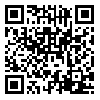Volume 7, Issue 6 (2-2012)
J Health Syst Res 2012, 7(6): 0-0 |
Back to browse issues page
Download citation:
BibTeX | RIS | EndNote | Medlars | ProCite | Reference Manager | RefWorks
Send citation to:



BibTeX | RIS | EndNote | Medlars | ProCite | Reference Manager | RefWorks
Send citation to:
فرزاد جليليان, مهدي ميرزايي علويجه, شهره امدادي, مجيد براتي, مصطفي نصيرزاده, ناصر حاتمزاده. پیشبینی عوامل مؤثر بر انجام تست پاپ اسمیر در بین زنان با بهرهگیری از مدل اعتقاد بهداشتی. J Health Syst Res 2012; 7 (6)
URL: http://hsr.mui.ac.ir/article-1-291-en.html
URL: http://hsr.mui.ac.ir/article-1-291-en.html
فرزاد جليليان1 
 , مهدي ميرزايي علويجه2
, مهدي ميرزايي علويجه2 
 , شهره امدادي3
, شهره امدادي3 
 , مجيد براتي1
, مجيد براتي1 
 , مصطفي نصيرزاده4
, مصطفي نصيرزاده4 
 , ناصر حاتمزاده5
, ناصر حاتمزاده5 


 , مهدي ميرزايي علويجه2
, مهدي ميرزايي علويجه2 
 , شهره امدادي3
, شهره امدادي3 
 , مجيد براتي1
, مجيد براتي1 
 , مصطفي نصيرزاده4
, مصطفي نصيرزاده4 
 , ناصر حاتمزاده5
, ناصر حاتمزاده5 

1- MSc, Lecturer, Department Nursing, Hamadan Branch, Islamic Azad University, Hamadan, Iran.
2- MSc Student, Department of Health Education, School of Health, Yazd University of Medical Sciences, Yazd, Iran.
3- PhD Candidate, Department of Public Health, School of Public Health, Hamadan University of Medical Sciences, Hamadan, Iran
4- MSc Student, Student Research Committee, Department of Health Education, School of Public Health, Isfahan University of Medical Sciences, Isfahan, Iran
5- PhD Candidate, Department of Health Education, School of Public Health, Yazd University of Medical Sciences, Yazd, Iran
2- MSc Student, Department of Health Education, School of Health, Yazd University of Medical Sciences, Yazd, Iran.
3- PhD Candidate, Department of Public Health, School of Public Health, Hamadan University of Medical Sciences, Hamadan, Iran
4- MSc Student, Student Research Committee, Department of Health Education, School of Public Health, Isfahan University of Medical Sciences, Isfahan, Iran
5- PhD Candidate, Department of Health Education, School of Public Health, Yazd University of Medical Sciences, Yazd, Iran
Abstract: (1133 Views)
Background: Cervical cancer is the second most common cancer among women in the world and the most common cancer in developing countries. Secondary prevention, achieved through Pap smear testing, is the single most effective tool in reducing deaths due to cervical cancer. The aim of this study was to determine factors affecting the belief to obtain a regular Pap smear test among women based on the health belief model. Methods: In a cross-sectional study, a total of 400 20-65 year-old women who referred to health centers in Hamadan, Iran were randomly selected to participate. The participants responded to the standard questionnaire. Data was analyzed by SPSS13. Findings: While 63.8% of the participants had obtained Pap smear test at least once, 28.3% reported regular Pap smear testing. There was a significant correlation between cervical cancer history in family and regular Pap smear testing (P < 0.05). In addition, there was a significant correlation between age and regular Pap smear testing (P < 0.05). A logit model was conducted for response variable and the best predictor of obtaining regular Pap smear test was perceived barriers (odds ratio = 0.878; P = 0.001). Conclusion: Women's health care professionals should be good information about factors related to cervical cancer screening. According to the results, designed strategies for reduce barriers to Pap smear test for obtain pap smear test among women can be useful.
Type of Study: Research |
Subject:
education health and promotion
Received: 2020/07/16 | Accepted: 2023/03/4 | Published: 2023/03/4
Received: 2020/07/16 | Accepted: 2023/03/4 | Published: 2023/03/4
| Rights and permissions | |
 |
This work is licensed under a Creative Commons Attribution-NonCommercial 4.0 International License. |



